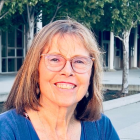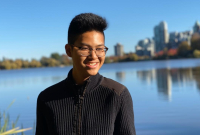Support strong Canadian climate journalism for 2025
As part of a series highlighting the work of young people in addressing the climate crisis, writer Patricia Lane interviews Naomi Leung, a high school student pushing for more climate education.
Naomi Leung
Naomi Leung wants the truth. She and fellow high school students leading Climate Education Reform BC (CERBC) believe schools must educate students to understand climate change is real and that it will change everything.
Tell us about your project.
We want to transform our education system so we are properly equipped for future challenges and opportunities that are coming as a result of climate change.
How did it get started?
A small group of Vancouver high school students realized that they did not learn what they know about climate change in school. Since climate change is not explicitly mentioned as a core concept or “big idea” for any mandatory course in the Grade 8 to 10 curriculum, what students learn varies widely. As a result, most students lack all but the most basic understanding of the climate emergency.
We learn nothing about the role that governments and industry have played, the urgency of the crisis or existing solutions. We had to connect the dots between colonialism, racism and social and economic injustice and climate change for ourselves. Yet these basic truths, as significant as anything else we will learn, are shaping the world we will enter as adults. As we prepare to enter the workforce, we must learn what roles we might play. The education system is supposed to be preparing us for our future, but it is missing in action. CERBC was formed to change that.
How is CERBC campaigning?
We are currently building awareness of six educational policy changes we need. We are building a network of school-based change-makers to create a student-informed basic K-12 curriculum that reflects the climate emergency, its impacts on our future and the importance of putting Indigenous knowledge at the forefront when identifying solutions. To help teachers and students get started right away, we also provide information about existing education resources developed over the past 10 years by Be The Change Earth Alliance, Oxfam Education, Bill Nye and NASA Kids. We ask students, parents and teachers to use their individual voices to support our collective call for action by joining our leadership team, taking measurable sustainable action, donating, writing letters to decision-makers and signing our petition.

How did you get involved?
As an Asian woman of colour, entering a predominantly white environmental movement has been difficult because voices like mine have historically been excluded. But after I learned about the student climate strikes on social media and watched a video with Greta Thurnberg, I attended a Sustainabiliteens climate strike with more than 100,000 people fighting for our future. As I listened to the speeches and felt the crowd around me, I was inspired. I knew I belonged and that this is what I needed to do. I got involved with Sustainabiliteens and shortly after, in its early days, with CERBC.
What keeps you awake at night with worry?
Climate breakdown already puts my family in Kuala Lumpur, Malaysia at risk with terrible air pollution and flash floods. It is not some future event for me or other Black, Indigenous or people of colour. It is happening now, and it will get much worse. While our decision-makers speak as if they care about climate, their lack of bold action shows they prioritize profit over protecting us all, especially our most marginalized communities.

What gives you hope?
Women, non-binary, Black, Indigenous and people of colour who continue to work for climate and racial justice give me hope. Our parents and some teens might not see direct action or open dissent as safe and this discourages some from participating. For economically marginalized students, the idea of participating in a school strike might mean time away from school when your family is making sacrifices for your education. It might mean being unable to look after your younger siblings or fragile elders while your parents work their second job. Yet we are coming out in greater and greater numbers with strong and resilient voices.
What would you like to say to other teenagers?
I want to speak especially to others who may look like me and not like the dominant face of environmentalism. Your voices are valuable and needed in the climate justice movement.
Do you have a message for older readers?
Encouraging us goes a long way. But you also have your own voices. Use them to stand up for our future. This means listening to and amplifying Indigenous land and water protectors and social economic and racial justice movements. They must have a voice at the table as we design the future we all need. And please sign CERB’s open letter and tell your MLAs and school boards that you want our education system to create the next generation of climate leaders ready to face the emergency already upon us.






Comments
I am full of admiration for the young people who are pushing to make study of this issue an essential part of their curriculum. It is a movement that is potentially highly productive in not only learning the complex interrelationships of our environmental sickness for themselves, but in being better positioned to argue for and pass that knowledge on to their parents and other older adults who may be less aware or less accepting of the emerging crisis.
The problem with this plan for the governing politicians is that it would strongly undermine their bland and misleading statements about their ongoing promotion and massive subsidisation of fossil fuel extraction and their continuing razing of the little remaining of our old growth forests. They can be counted on to give it lip service while doing everything they can to stymie its full implementation.